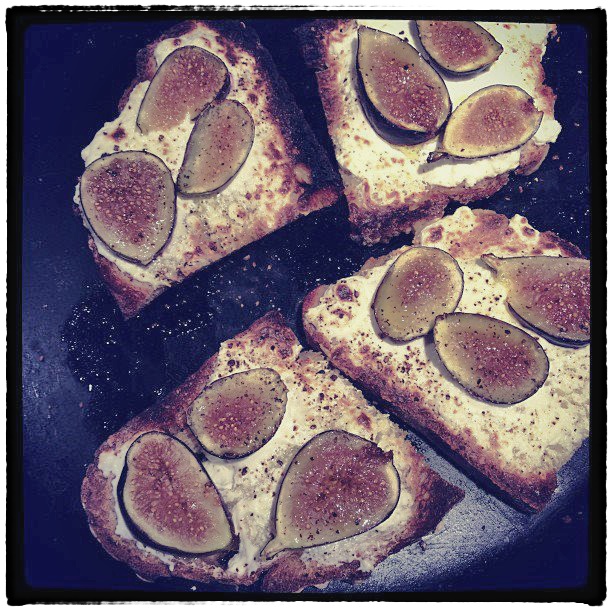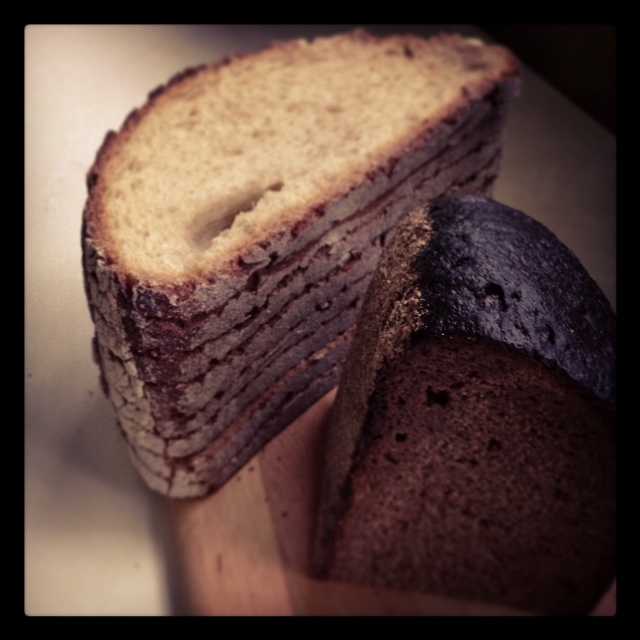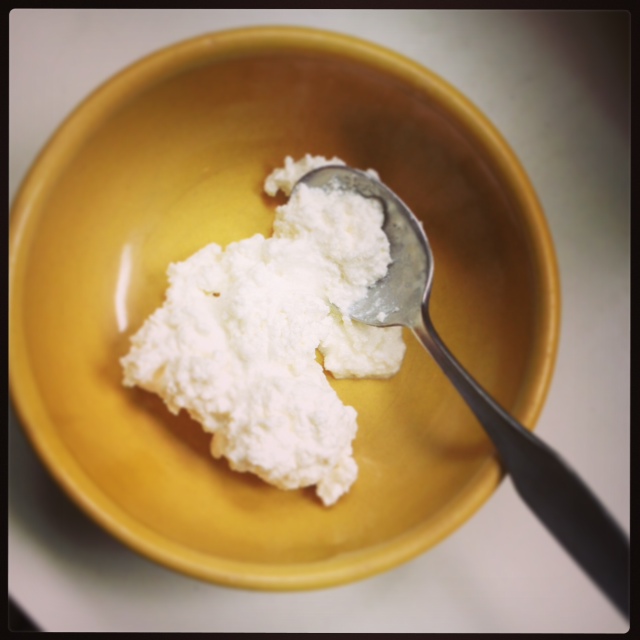In my kitchen right now are two loaves of sourdough bread, both from Bread Alone (because the last time I tried to make a sourdough starter, it began with great promise and then turned gray and sloggy, and then I became obsessed with it like it was a small child who had stopped eating. Sam Fromartz and Dan Leader, I’m sure you can help me with this.). On my way home from my Mother’s Day visit in Manhattan, I pulled over at Fairway to pick up two loaves of Latvian black bread from the Black Rooster bakery, which — I’ve been assured by people who know about Latvian black bread — is as close to the real thing as I might get, even though I used to love the pungently sour ebony loaves from the long-closed Juris Kupris Bakery of Bolton Connecticut, which was first introduced to me through Laurie Colwin’s writing, many years ago.
See what happens when I get it into my tiny brain that I might have a gluten sensitivity? I start lining every inch of my kitchen with bread. As a test, of course. Because nothing says pleasure like denial. And hives. But here’s my good news (I’ve been experimenting): bread as I know it — the really good stuff, like real sourdough — apparently does not have to be banished from my life or my home or my plate. I don’t have to don a surgical mask and clean every trace of it from my house the way my bubbe did before Passover. The bad news: I just can’t eat junk bread. And if you’re my age, or near my age, you probably know what I mean when I say junk bread.
Remember that commercial from years ago — it was probably in the mid-1970s — where the sweet, down-home music swelled in the background and some nice, faceless lady in gingham ladled a gorgeous and heart-stopping quantity of melted golden butter right down the center of a loaf of “home-baked white bread” and filled it with “buttery goodness?” That’s junk bread. Any bread that can sit on store shelves for a month and stay soft and fresh with nary a fleck of green mold is junk bread. The diet white bread that my mother used to make my school sandwiches on (which either disintegrated in my hands, covering my prepubescent lap with very wet tuna salad, or my apple rolled over it and by the time I got to school the sandwich took on the appearance of a football shoulder pad designed for a Chihuahua) is junk bread.
I’m not going to go on a rant about what scientifically constitutes junk bread, and why it seems to be a major culprit in the remarkable gluten intolerance/celiac pandemic that is currently impacting virtually every modernized country on earth. But someone asked me recently why now, why so suddenly. Honestly, I don’t think any of us has the answer except for the fact that we — humans, our genome, our ability to metabolize the profusion of chemicals that we’re faced with every day and have been faced with since probably the 1930s (when chemically preserving food for long transports was key to feeding America’s starving millions) but certainly since 1974, when a certain infamous herbicide hit the scene — may have hit the proverbial wall, and the only way around it is to switch gears. For some, that means no more bread, and no more gluten of any kind. I’m one of the other ones; I just have to alter what I eat and how often I eat it, which is fine with me. It just means listening to my body a little bit more closely than I have of late, so I’m looking at it as a sort of lesson: I will be eating bread only when I know it’s great, when I’m feeling good, and when the stuff I’m putting on said great bread actually excites me, the way it did the other day, when I brought home a tub of fresh ricotta from Murray’s and a bag of Mission figs.
Like bread (and butter), fresh ricotta is one of those mundane things that we all just tend to take with a grain of salt, because (like bread and butter) it’s ubiquitous: most of us, unless we grew up in a yurt, have experienced ricotta in virtually every permutation — on pizza, in pasta, in ravioli, in cannoli, as cheesecake, in lasagna — and spooned out of a plastic container found in your supermarket’s refrigerated case next to those blocks of mozzarella that bounce. (You know what I’m talking about.)
But good ricotta is bliss; it’s sweet and milky and fresh and sexy, and once you taste it, you pretty much want to smear it on everything you can. This week, I’ve had it a couple of ways: spread on sourdough toast, topped with a filmy layer of Prosciutto di Parma, and drizzled with strong, peppery olive oil. That was nice. But what was better — and what became dinner the other night — was ricotta spread on sourdough that had been brushed with olive oil and broiled lightly in a cast iron pan, topped with thinly-sliced Mission figs, drizzled with honey, a little bit more oil, and salt and pepper to take the edge off the richness of the cheese and the sweetness of the fruit, and popped back under the broiler for a minute.
Of course, you can make this on any good bread, and you should. And IF you are a gluten sensitive person, or a Celiac, or you’re just being careful, there are dozens of great quality GF breads out there for you to try. So I suggest you make it with whatever you have at hand.
Except junk bread.
Ricotta and Mission Fig Tartine with Honey, Salt & Pepper
The combination of creamy milk, sweet honey and luscious fruit, tangy sourdough, and earthy salt and pepper is a remarkable one, and (with the exception of the sourdough) something I remember reading about in one of Ada Boni’s wonderful books. Or maybe Patience Gray’s Honey from a Weed. Anyway, it’s a nearly biblical combination that is so satisfying and lusty you’ll want a cigarette after you eat it.
Serves 2
extra virgin olive oil for brushing and drizzling
2 large slices excellent quality sourdough, cut in half
1/4 cup very fresh, full fat cow’s milk ricotta
4 burstingly-ripe Mission figs, thinly sliced length-wise into thirds
honey for drizzling
salt and freshly ground black pepper, to taste
Place an oven rack approximately 7 inches from your oven’s upper heat source, and preheat your broiler.
Lightly brush one side of each bread slice with olive oil, place oily-side up in a large cast iron pan, and toast under the broiler until golden, and remove from oven.
Turn each slice over, untoasted side up, and lightly brush with a bit more olive oil. Evenly spread each slice with ricotta and top with the sliced figs. Drizzle with honey and a shower of salt and freshly ground black pepper.
Drizzle with a bit more oil and pop back under the broiler until the bread is golden, the ricotta slightly blistered in spots, and the figs knife-tender. Serve immediately.







I have to wonder: why would anyone in their right mind want to eat junk bread anyway, when, if you are too lazy to make a loaf of good bread yourself, it’s so easy to find some at a store or bakery? What qualifies as “junk” bread around here is pre-sliced organic whole wheat from TJs. For when I am, in fact, too lazy to make good bread myself.
Because, unfortunately, it’s ubiquitous in our culture. Many folks just don’t know any better, and they believe that when a chemical-laden loaf is stamped “farm fresh” that it actually is. The same way that they think eggs marked “free range” are.
I made a New Year’s resolution to ONLY eat bread I made myself. With my busy schedule, that did NOT pan out. However, I have cut out most “junk bread” and aside from some tortillas I bought, probably have been mostly successful. Good bread is worth it.
Amen sistah!
I love this, and I am so deeply happy for your discovery. But I’m sorry Elissa, I hate you right now for tempting me with ricotta and figs. My God! The layers of olive oil and cheese and pepper and salt and oil and honey and sweet, gorgeous figs (which, in case you’re wondering even in California I can’t get my hands on right now in my po-dunk town, because they are still hard green fists on the trees)! Dairy and me aren’t friends! And now I am going to have to wait, panting, for another month or two just to eat this and then get those virtuous hives. Oh the agony!
I don’t have any citations, but I keep hearing that the GMO wheat might be partially to blame (which shows up in junk bread more than artisan breads). Which reminds me, I need to go query my beloved King Arthur … I can get non-GMO Montana Wheat flour everywhere here (in MT) but the texture is off … grr.
The best ricotta I ever had was from Gioia, a small company in Los Angeles that is mostly famous for its burrata. It tasted so much like milk – fresh, grassy, incredible milk – and had such a light, creamy, fluffy texture that it felt like eating a cow-filled cloud. Well, that doesn’t sound right, but it really was incredible. One of those snapshot flavors and food experiences that I can still remember perfectly …
I had fresh ricotta from a farm on Vashon where I live and you are right is is glorious….I now wil lbe stealing that phrase for great food from you- “so satisfying and lusty you’ll want a cigarette after you eat it”. I wil give you credit, I love to talk about food writers.
I have never heard such a perfect decrisption or reason to try a recipe.
Actually,it isn’t that easy to find good bread, especially if you do most of you grocery shopping in a supermarket. Most people think that the bread made by the store bakery is good bread, when it generally comes pre-mixed and is simply baked off. Even so-called artisan bread is often disappointing. I have found the best solution is to make my own bread, which is really not very time-consuming or difficult. There are several excellent sources for recipes. The one I bake most often is a whole wheat organic King Arthur flour “wonder bread” from Rose Levy Beranbaum’s “Bread Bible”. This is amazingly-good bread! And it takes about 10 minutes hands-on time in the evening, after which it goes in the refrigerator overnight (creating wonderful flavor). The next day, you let it rise twice, once in a bowl, then in two loaf pans. Then you bake it for half an hour and you have two totally delicious loaves, for making sandwiches or just for snacking. It’s that good. All the kneading is done by my Kitchen-Aid mixer, for 7 minutes prior to the two rises. This bread adjusts to your schedule, so there’s no stress about when you remove it from the refrigerator. Furthermore, it’s not expensive, like store-bought artisan bread can be. I apologize for being so wordy, but I’m incredibly enthusiastic about this . It’s funny, I dreaded baking with yeast before, thinking it was some sort of deep mystery, requiring skills which I was sure I couldn’t master. In reality, it’s truly easy, with a hugely-off!
“huge pay-off” is what I meant.
Everything has consequences and how could we expect to not have consequences from plaguing real food with chemicals and stripping them of nutrients? hence all the diseases and food sensitivities of our days, we tainted with the ways of nature externally and the consequences show up internally. I remember when I had my food enlightenment, because like you say it is a society/cultural thing and people just don’t know better, I thought I had cancer and every disease in the books of how bad I felt… Changed my diet and changed my health. Glad you can still enjoy some REAL bread 🙂